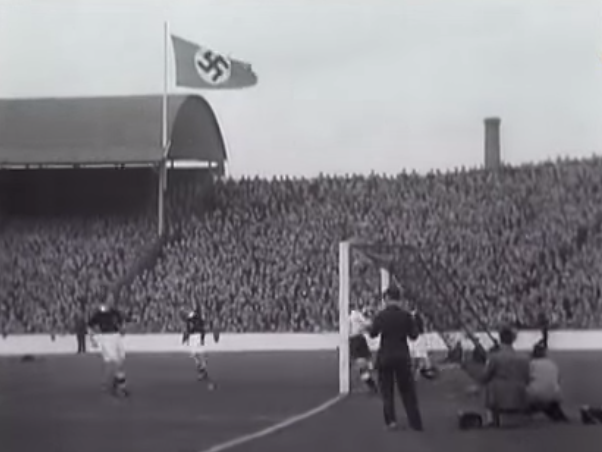Archive video shows Nazi flag flying in Glasgow; Hitler salute in London – but what should we read into it?
Understanding how symbols of Hitler's Germany - the swastika, the salute - had not gained the notoriety and connotations that they hold today during the mid-1930s

A Nazi flag flying over Ibrox, a "Heil Hitler" salute in London.
With the release of 1 million minutes of archive footage by the Associated Press and British Movietone, described as the "the largest upload of historical news content on YouTube to date," two video clips from 1936 provide an insight into how the Nazi regime was viewed in the UK: especially how symbols of Hitler's Germany - the swastika, the salute - had not gained the notoriety and connotations that they hold today.
Such archive video helps to shed light on the recent furore surrounding Her Majesty the Queen, after The Sun newspaper published video showing the current Queen seemingly giving a Nazi salute when she was a child.
Shot in 1933 on the Balmoral estate, apparently with the Queen’s father behind the camera, the grainy footage shows Elizabeth playing on a lawn with her sister Margaret before her mother makes a Nazi salute. The Queen then mimics her mother’s gesture before being joined by her uncle, who would later abdicate in 1936.
While such videos - of the Queen giving the salute or of the swastika flying over Glasgow - may cause much alarm in 2015, that is because of hindsight and of what happened after these videos - from 1933 and 1936 - were shot.
Professor Neil Gregor from Southampton University says the footage of the flag in particular is easy to explain, simply because the Nazi banner was the national flag of Germany and protocol dictated that it be flown at certain events, such as at football matches or, as in the video, of the burial of German Leopold von Hoesch.
"It doesn't signify sympathy or appeasement on the part of British participants in either event," said Professor Gregor. "Naturally, it's striking to us now to see such a symbol becoming part of the fabric of everyday life in British society, but its presence doesn't always imply pro-fascist attitudes. Such attitudes were undoubtedly there, as many historians have shown, but this is not evidence for them."
Sympathy for Germany
"There was a great deal of sympathy of Hitler's ideas amongst upper class Britons in the early 1930s," said Dr Hester Vaizey, Cambridge University lecturer in Modern German History. "In British eyes, despite World War I, Germany was a cultured nation, producing great music and literature. Lots of young women were sent from Britain to finishing school in Germany at this time."
Professor David Welch from the University of Kent adds that a large section of British society felt that Germany had been unfairly punished under the Treaty of Versailles.
Hatred of the Communists
To 21st-century eyes, Nazi Germany may seem the most pressing issue of the day. However, fascism paled in comparison to the threat of communism. "The British government clearly feared the rise of Bolshevism more than the German nationalists," Professor Welch writes. "You can see from the scale of the funeral of the German ambassador how important maintaining good relations were for the British government."
Dr Helen Roche, a research fellow at Lucy Cavendish College, Cambridge, adds that while there was a "predominantly positive" attitude towards Hitler among the British Establishment, "among the general public as well, Bolshevism was often seen as a far greater danger than 'Hitlerism'".
Desire to avoid war
Dr Welch points out that Mass-Observation was established in 1937 and began to chart British public opinion. Not only did the social research of MO discover that the public were more fearful of the Communists, "the overriding concern was to avoid another war."
"The British and French governments appeasement continued untrammelled," Dr Welch said, "and in May 1938 in the Berlin Olympic stadium the English football team was virtually instructed to give the Nazi salute before the game - weeks after Hitler had illegally annexed Austria into the German Reich (so little change in attitude to 1936 newsreel of the Scottish football teams and the Nazi salute)."
Germany not at the forefront
Dr Roche said that one should not read too much into the videos because "all we can say is that people probably didn't know or care enough about what was going on in Nazi Germany to feel moved to protest at the fact that the swastika was being flown.
"The problem," Dr Roche continues, "is it's always easy to let hindsight regarding the Holocaust make such apathy or disinterest appear more damning than it might have seemed at the time."
Subscribe to Independent Premium to bookmark this article
Want to bookmark your favourite articles and stories to read or reference later? Start your Independent Premium subscription today.
